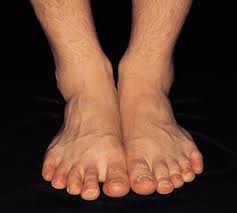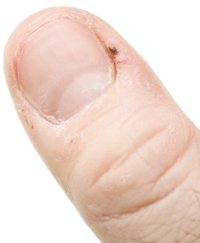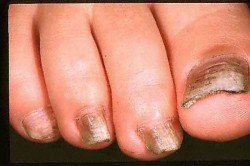Archive for the ‘Nail Fungus Cause’ Category
Onychoschizia – Split Nails
Onychoschizia – Split Nails
 Onychoschizia is a condition in which the nail split or falls apart easily. Typically people who have Onychoschizia have nails that are very fragile, squashy, and thin or that have funny “crumple” lines. Sufferers are more prone to nail infections. Onychoschizia is most commonly found in women.
Onychoschizia is a condition in which the nail split or falls apart easily. Typically people who have Onychoschizia have nails that are very fragile, squashy, and thin or that have funny “crumple” lines. Sufferers are more prone to nail infections. Onychoschizia is most commonly found in women.
What Causes Onychoschizia?
- Long periods of being submerged in water or chemical baths
- Poor nutrition
- Vitamin Deficits
- Applying nail polish remover
- Stress
How to Deal With Onychoschizia
- Wear protective gloves whenever working with chemicals (household or otherwise) or immersing hands in water for a long period of time.
- Use ointments or lotions that contain alpha hydroxyl acid, for instance, Lanolin or Neostrata, especially after washing your hands and/or feet
- Do not use your fingernails to dial a telephone or to type as the repeated stress will cause your nails to break
- Pay attention to how people with healthy fingernails treat them
- Wear gloves during the winter to help protect your nails from possible infection
- Trim and file your nails to a nice shape at the tip so that there is less risk of breakage.
- Do not buff the bulk of the nail as this can strip away necessary protective layers
- Taking biotin in 2.4 milligram doses as a daily supplement can help with healthy nail growth. Please note: this should not be done by women who are pregnant.
- Including a daily dose of Knox Gelatin, mixed with fruit juice, every day can help to increase nail strength.
- Taking nutritional supplements to help increase healthy nail growth
- Wearing nail polish with nylon fiber can help to strengthen and protect the nail.
Nail Fungus Prevention Tips
Nail Fungus Prevention Tips
 “An ounce of prevention is worth a pound of cure.” So goes the old proverb and this is very true in the case of nail fungus prevention. Avoiding infection of your nails is a fairly simple process, but it does require diligence on your part. When you consider that once an infection has established itself, it is much more difficult to cure, working on prevention is in everyone’s best interest.
“An ounce of prevention is worth a pound of cure.” So goes the old proverb and this is very true in the case of nail fungus prevention. Avoiding infection of your nails is a fairly simple process, but it does require diligence on your part. When you consider that once an infection has established itself, it is much more difficult to cure, working on prevention is in everyone’s best interest.
The main problem is that nail fungus is not choosy about who it attacks. If it can find a successful living environment, it will.
People who are most subject to nail fungus infections are:
- People who sweat excessively in their hands and/or feet
- People who already have some sort of nail disorder
- People who have a weakened immune system
The risk of getting or not getting this disease seems to be fairly random. It will live wherever it can so “your best offense is a good defense”.
Prevention ideas
- Wear some sort of protective footwear when you are in public places where there is a lot of water, locker rooms, public baths and swimming pools are good examples. As you have no idea who may accidentally pass the spores along, protecting your own feet is paramount.
- Keep your nails short, clean, and dry. Trim and file your nails regularly to ensure that they are clean all over. Washing your hands and feet with soap and drying thoroughly afterward is also important as fungi like damp, dark places.
- Use antifungal sprays or powders to fight off the spores you may have already accidentally collected. Air out and dry out your shoes after wearing (especially if your feet sweat) and change your socks daily or wear sandals as often as possible.
- Don’t use nail polish as this locks in humidity and usually blocks light that might reach the fungus and help kill it off.
- If you choose to get manicures or pedicures, check with your salon to make sure they sterilize all of their equipment.
- Wash and dry your hands thoroughly before applying anything to your hands or feet and after applying ointment or medication anywhere else.
- Do not pick at the skin around your nails as this can cause irritation and allow the fungus to invade your skin.
- Pay attention to developing symptoms and if they show up, treat them early on to nip the infection in the bud
- Eat a healthy and balanced diet so that your immune system is up to fighting off any infection that comes your way.
Your health is in your own hands so grab it and go with it to keep your nails looking healthy and happy.
About the Condition Called Hangnails
About the Condition Called Hangnails
 Everyone wants to have healthy, attractive nails. However many people have hangnails. It is probably the most common nail ailment that humans face. There are various things we can do to prevent hangnails from developing and destroying the aesthetic beauty of the hand. Hangnails are not only unattractive, they tend to catch on hair, clothing, and other surrounding objects and can cause sudden and severe pain if they are bent backward to far. Many people look for ways to stop development of this irritating little problem. There are some simple solutions to avoiding hangnails.
Everyone wants to have healthy, attractive nails. However many people have hangnails. It is probably the most common nail ailment that humans face. There are various things we can do to prevent hangnails from developing and destroying the aesthetic beauty of the hand. Hangnails are not only unattractive, they tend to catch on hair, clothing, and other surrounding objects and can cause sudden and severe pain if they are bent backward to far. Many people look for ways to stop development of this irritating little problem. There are some simple solutions to avoiding hangnails.
What is a Hangnail?
Excess skin builds up around the base and side of the nail, the partially detaches from the nail itself, causing it to stick up and bend back. This can be very painful, as can trying to remove the hangnail, whether by cutting, biting or ripping it off.
What Causes Hangnails?
Hangnails are usually caused by dry cuticles. The cuticle is the skin that surrounds the nail, most commonly seen at the base of the nail. When the cuticle dries out it breaks and the skin detaches from the nail, creating a hangnail. If a person with a hangnail picks at it, bites at it or rips it off, it makes it more likely that this condition will continue as it just exacerbates the problem. People who spend a lot of time with their hands in water tend to suffer from hangnails as the skin gets soft and is then easily damaged. People who bite their nails are also more prone to hangnail. Children who bite their nails are usually afflicted with this nuisance.
How Do I Prevent Hangnails?
The easiest way to prevent hangnails from developing is to moisturize the cuticles. This is definitely a situation where preventing the problem is far better than dealing with it once it has occurred.
Some simple hangnail prevention tips:
- Don’t bite or rip off your hangnails. This frequently causes bleeding and may lead to infection. Use a small nail scissor to cut it close to the base which will inhibit further deterioration.
- Soak your hand in warm water for 5-10 minutes, dry thoroughly, then apply a moisturizing cream or oil to the skin surrounding the nails.
- Learn to stop biting your nails. If it’s really hard to stop, then investigate products that you can apply to your nails that will make them taste bad to help you resist the urge.
- Wear protective gloves when using harsh cleaning products or when you will have your hands immersed in liquid for a long period of time.
8 Good Questions to Ask About Nail Fungus
8 Good Questions to Ask About Nail Fungus
 Nail fungus is a global problem. Many people do not understand how nail fungus infections are contracted, nor how to prevent them.
Nail fungus is a global problem. Many people do not understand how nail fungus infections are contracted, nor how to prevent them.
Here are 8 great questions, answered for your enlightenment, so you understand what fungal nail infections are and what causes them.
What is a nail fungus infection?
Dermaphytes, a microscopic organism are usually the culprit of nail fungus. As they are a fungal life form, they don’t require light to grow. The spores cause the nails to become yellowed and thick.
Why does the nail provide such a great place for the fungus to live?
Fungus likes to live where it is dark, warm and damp. The inside of socks and shoes is an ideal environment for these microorganisms to thrive.
Is everyone prone to contracting nail fungus?
Yes, everyone has the potential to develop a fungal nail infection. People become more prone to attack as they age.
Is it contagious?
It is, although it is most likely to be passed from person to person if you have abraded nails or damage to your skin. Public pools, locker rooms and public baths are all places where nail fungus spores are spread.
Are my fingernails or toenails more likely to become infected?
Toenails are more likely to become infected as they spend more time in enclosed environments and closer to the ground where the fungus may be living.
Is this infection dangerous?
Not in and of itself, although the infection can become serious if not treated. The disease becomes more dangerous if a patient has other diseases that make them more vulnerable to fungal nail infection.
Can I still wear nail polish?
No. While you are undergoing treatment of any kind for fungal nail infection your nails need to breathe. Nail polish creates a barrier between the air and your nail and it seals in humidity which make for a better growing environment for the fungus.
Will it go away on its own?
No it won’t. The faster you catch this infection, the easier it is to cure. The longer you let it go, the harder it will be to recover. Topical medications and home remedies can be very effective if you catch the problem early on.